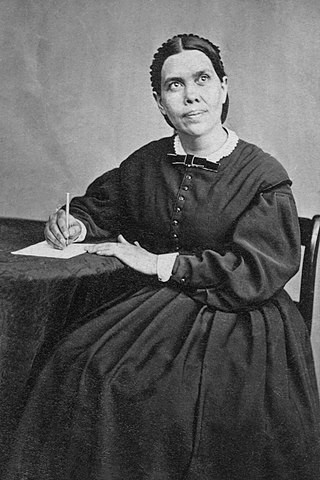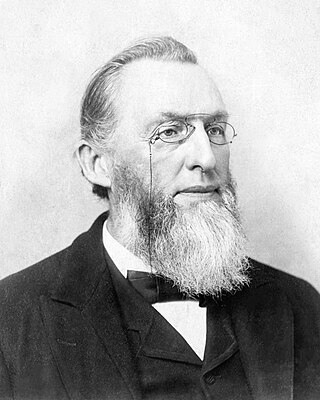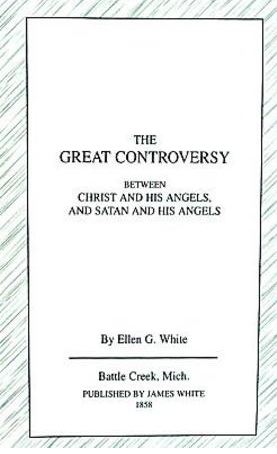
The Seventh-day Adventist Church (SDA) is an Adventist Protestant Christian denomination which is distinguished by its observance of Saturday, the seventh day of the week in the Christian (Gregorian) and the Hebrew calendar, as the Sabbath, its emphasis on the imminent Second Coming (advent) of Jesus Christ, and its annihilationist soteriology. The denomination grew out of the Millerite movement in the United States during the mid-19th century and it was formally established in 1863. Among its co-founders was Ellen G. White, whose extensive writings are still held in high regard by the church.

Ellen Gould White was an American author and co-founder of the Seventh-day Adventist Church. Along with other Adventist leaders such as Joseph Bates and her husband James White, she was instrumental within a small group of early Adventists who formed what became known as the Seventh-day Adventist Church. White is considered a leading figure in American vegetarian history. Smithsonian named her among the "100 Most Significant Americans of All Time".

The Seventh-day Adventist Church had its roots in the Millerite movement of the 1830s to the 1840s, during the period of the Second Great Awakening, and was officially founded in 1863. Prominent figures in the early church included Hiram Edson, Ellen G. White, her husband James Springer White, Joseph Bates, and J. N. Andrews. Over the ensuing decades the church expanded from its original base in New England to become an international organization. Significant developments such the reviews initiated by evangelicals Donald Barnhouse and Walter Martin, in the 20th century led to its recognition as a Christian denomination.
Criticism of the Seventh-day Adventist Church includes observations made about its teachings, structure, and practices or theological disagreements from various individuals and groups.
Last Generation Theology (LGT) or "final generation" theology is a religious belief regarding moral perfection achieved by sanctified people in the last generation before the Second Coming of Jesus. It was a concept that had its origins in the beliefs and teachings of Seventh-day Adventist Church pioneers, and there are verses in scripture in texts such as 2 Corinthians 7:1, Matthew 5:48, and many others. Seventh-day Adventists hold that there will be an end-time remnant of believers who are faithful to God, which will be manifest shortly prior to the second coming of Jesus, as suggested by the 144,000 saints described in the Book of Revelation of the New Testament.

Uriah Smith was a Seventh-day Adventist author, minister, educator, and theologian who is best known as the longest serving editor of the Review and Herald for over 50 years.
Herbert Edgar Douglass Jr. was a Seventh-day Adventist theologian. He was born in Springfield, Massachusetts, US, the oldest of five children to Herbert Edgar Douglass Sr (1904–1983) and Mildred Jennie Munson (1908–1988). He earned his Doctorate in Theology at Pacific School of Religion in 1964.
The investigative judgment, or pre-Advent Judgment, is a unique Seventh-day Adventist doctrine, which asserts that the divine judgment of professed Christians has been in progress since 1844. It is intimately related to the history of the Seventh-day Adventist Church and was described by one of the church's pioneers Ellen G. White as one of the pillars of Adventist belief. It is a major component of the broader Adventist understanding of the "heavenly sanctuary", and the two are sometimes spoken of interchangeably.

The Seventh-day Adventist Church holds a unique system of eschatological beliefs. Adventist eschatology, which is based on a historicist interpretation of prophecy, is characterised principally by the premillennial Second Coming of Christ. Traditionally, the church has taught that the Second Coming will be preceded by a global crisis with the Sabbath as a central issue. At Jesus' return, the righteous will be taken to heaven for one thousand years. After the millennium the unsaved cease to exist as they will be punished by annihilation while the saved will live on a recreated Earth for eternity.

The Great Controversy is a book by Ellen G. White, one of the founders of the Seventh-day Adventist Church, and held in esteem as a prophetess or messenger of God among Seventh-day Adventist members. In it, White describes the "Great Controversy theme" between Jesus Christ and Satan, as played out over the millennia from its start in heaven, to its final end when the remnant who are faithful to God will be taken to heaven at the Second Advent of Christ, and the world is destroyed and recreated. Regarding the reason for writing the book, the author reported, "In this vision at Lovett's Grove, most of the matter of the Great Controversy which I had seen ten years before, was repeated, and I was shown that I must write it out."
The theology of the Seventh-day Adventist Church resembles that of Protestant Christianity, combining elements from Lutheran, Wesleyan-Arminian, and Anabaptist branches of Protestantism. Adventists believe in the infallibility of the Scripture's teaching regarding salvation, which comes from grace through faith in Jesus Christ. The 28 fundamental beliefs constitute the church's current doctrinal positions, but they are revisable under the guidance of the Holy Spirit, and are not a creed.
Most Seventh-day Adventists believe church co-founder Ellen G. White (1827–1915) was inspired by God as a prophet, today understood as a manifestation of the New Testament "gift of prophecy," as described in the official beliefs of the church. Her works are officially considered to hold a secondary role to the Bible, but in practice there is wide variation among Adventists as to exactly how much authority should be attributed to her writings. With understanding she claimed was received in visions, White made administrative decisions and gave personal messages of encouragement or rebuke to church members. Seventh-day Adventists believe that only the Bible is sufficient for forming doctrines and beliefs, a position Ellen White supported by statements inclusive of, "the Bible, and the Bible alone, is our rule of faith".
The 1888 Minneapolis General Conference Session was a meeting of the General Conference of Seventh-day Adventists held in Minneapolis, Minnesota, in October 1888. It is regarded as a landmark event in the history of the Seventh-day Adventist Church. Key participants were Alonzo T. Jones and Ellet J. Waggoner, who presented a message on justification supported by Ellen G. White, but resisted by leaders such as G. I. Butler, Uriah Smith and others. The session discussed crucial theological issues such as the meaning of "righteousness by faith", the nature of the Godhead, the relationship between law and grace, and Justification and its relationship to Sanctification.
Ellen G. White, one of the co-founders of the Seventh-day Adventist Church, was extremely influential on the church, which considers her a prophet, understood today as an expression of the New Testament spiritual gift of prophecy. She was a voluminous writer and popular speaker on health and temperance. Her teachings are preserved today through over 50,000 manuscript pages of her writings, and the records of others.

Arthur Grosvenor Daniells was a Seventh-day Adventist minister and administrator, most notably the longest serving president of the General Conference. He began to work for the church in Texas in 1878 with Robert M. Kilgore and also served as secretary to James and Ellen White for one year, and later worked as an evangelist. In 1886, he was called to New Zealand, and was one of the pioneers of the Seventh-day Adventist Church in the South Pacific. Daniells had astounding success through his dynamic preaching and on October 15, 1887, he opened the first Seventh-day Adventist church in New Zealand at Ponsonby. While there he served as president of the New Zealand Conference , and of the Australia Conference. Later, he became the president of the Australasia Union Conference before becoming president of the General Conference in 1901 and served as president until 1922.

The Desire of Ages (DA) is a book about the life and teachings of Jesus Christ, written by the Seventh-day Adventist pioneer Ellen G. White. It was first published in 1898.
The Conflict of the Ages is a book series written by American religious author Ellen G. White (1827–1915).
Seventh-day Adventists believe that Ellen G. White, one of the church's co-founders, was a prophetess, understood today as an expression of the New Testament spiritual gift of prophecy.
The Seventh-day Adventist Church pioneers were members of Seventh-day Adventist Church, part of the group of Millerites, who came together after the Great Disappointment across the United States and formed the Seventh-day Adventist Church. In 1860, the pioneers of the fledgling movement settled on the name, Seventh-day Adventist, representative of the church's distinguishing beliefs. Three years later, on May 21, 1863, the General Conference of Seventh-day Adventists was formed and the movement became an official organization.
The Pillars of Adventism are landmark doctrines for Seventh-day Adventists. They are Bible doctrines that define who they are as a people of faith; doctrines that are "non-negotiables" in Adventist theology. The Seventh-day Adventist church teaches that these Pillars are needed to prepare the world for the second coming of Jesus Christ, and sees them as a central part of its own mission. Adventists teach that the Seventh-day Adventist Church doctrines were both a continuation of the reformation started in the 16th century and a movement of the end time rising from the Millerites, bringing God's final messages and warnings to the world.








